Natural Ventilation: Principles and Strategies
Natural ventilation is a sustainable and efficient approach to maintaining a comfortable and healthy environment, taking advantage of available natural resources, such as fresh air and external air flows. The demand for sustainable practices and ‘green’ buildings has grown substantially, making natural ventilation a star in modern architectural design.
There are various strategies that can be adopted to promote natural ventilation in a space. One of them is the use of openings, such as windows and doors, which allow air to enter and exit. It is important to position these openings strategically, taking into account factors such as the direction of prevailing winds and solar incidence. In this way, it is possible to make the most of external air flows to cool the environment.
Another interesting strategy is to use architectural elements that favour cross ventilation. This means positioning openings on opposite walls to allow efficient air passage. Cross ventilation creates a continuous air current, renewing indoor air and reducing the feeling of stuffiness. We have a post about the use of cobogó in architecture, which is also related to the use of natural ventilation to promote more comfortable spaces. You can read by clicking here.
Additionally, it is important to consider the use of natural elements, such as vegetation, to aid in natural ventilation. Trees and plants can be strategically positioned to create shade and mitigate the impact of external heat. The evapotranspiration of plants also helps to cool the surrounding air.
Principle of Driving Forces for Natural Ventilation
There are several driving forces that propel natural ventilation in an environment. These forces are influenced by external and internal factors and play an important role in air circulation. Some of the main drivers of natural ventilation are:
- Temperature difference: The temperature difference between the interior and exterior of an environment creates a driving force for ventilation. Hot air tends to rise, while cold air tends to descend. This temperature difference creates an air current that allows air renewal.
- Pressure difference: The pressure difference between the interior and exterior of an environment is also a driving force for natural ventilation. If the internal pressure is higher than the external, air will be expelled outwards. If the internal pressure is lower, external air will be pulled inwards.
- Wind: Wind action is one of the main driving forces for natural ventilation. Wind creates pressure on the external surfaces of the environment, generating a pressure difference that allows air to enter or exit.
- Stack effect: The stack effect occurs when there is a temperature difference between the top and base of an environment. Hot air rises and is expelled through openings at the top, while cold air is pulled in through openings at the base. This effect creates a natural air circulation.
- Natural convection: Natural convection is a process in which hot air expands, becoming less dense and rising, while cold air contracts, becoming denser and descending. This convection movement creates natural ventilation.
These driving forces can be harnessed to design buildings with an efficient ventilation system, reducing dependence on mechanical ventilation systems and promoting sustainability.
The Wind Rose to Plan Natural Ventilation
When designing a space with a focus on natural ventilation, it is also fundamental to take into account the climatic characteristics of the region. Aspects such as average temperature, humidity, and wind speed should be analysed to ensure an efficient project. Additionally, it is important to consider the solar orientation of the space, as this can directly influence the amount of heat received and the need for ventilation.
The Wind Rose, for example, is a graphical representation that plays a fundamental role in indicating the directions and winds of a specific region. Composed of four main directions – North, South, East, and West – and their respective intermediate directions, this instrument is an essential component to assist in geographical orientation.
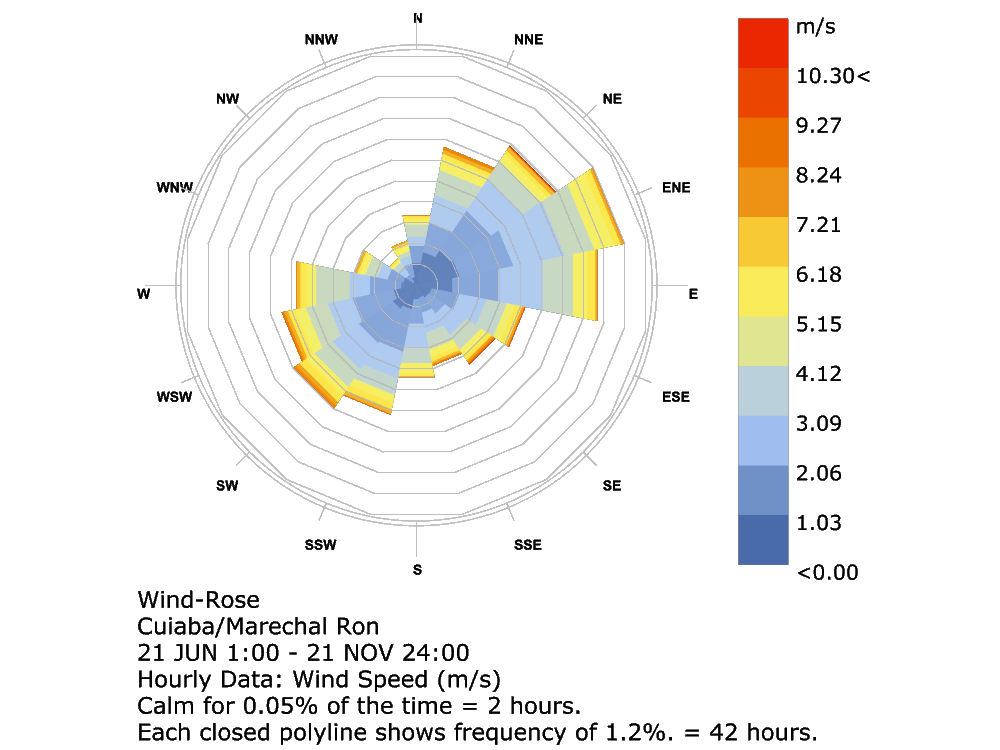
Example of a Wind Rose – Analysis generated by Rhinoceros + Grasshopper software, Ladybug plugin.
To effectively plan the natural ventilation of a building or house using the Wind Rose, it is essential to understand and analyse the predominance of winds in the region in question. With this valuable information in hand, you can strategically plan the location and positioning of windows and other openings in your house in order to make the most of natural ventilation, promoting passive ventilation, not so dependent on active cooling systems such as air conditioning.
For example, if the prevailing winds in your locality come mostly from the south, you can consider placing windows or openings in that specific direction to allow the entry and circulation of wind. Similarly, it is possible to position openings on opposite sides of the house to allow air to flow freely through the house, creating natural residential ventilation through cross ventilation. This type of planning can not only improve air quality inside the house but also contribute to energy saving, reducing the need for fans or air conditioning.
We also have a post about the importance of air circulation for comfort and energy efficiency, here, and also a post about tools for thermal comfort analysis, which you can access by clicking here.
Natural Ventilation System
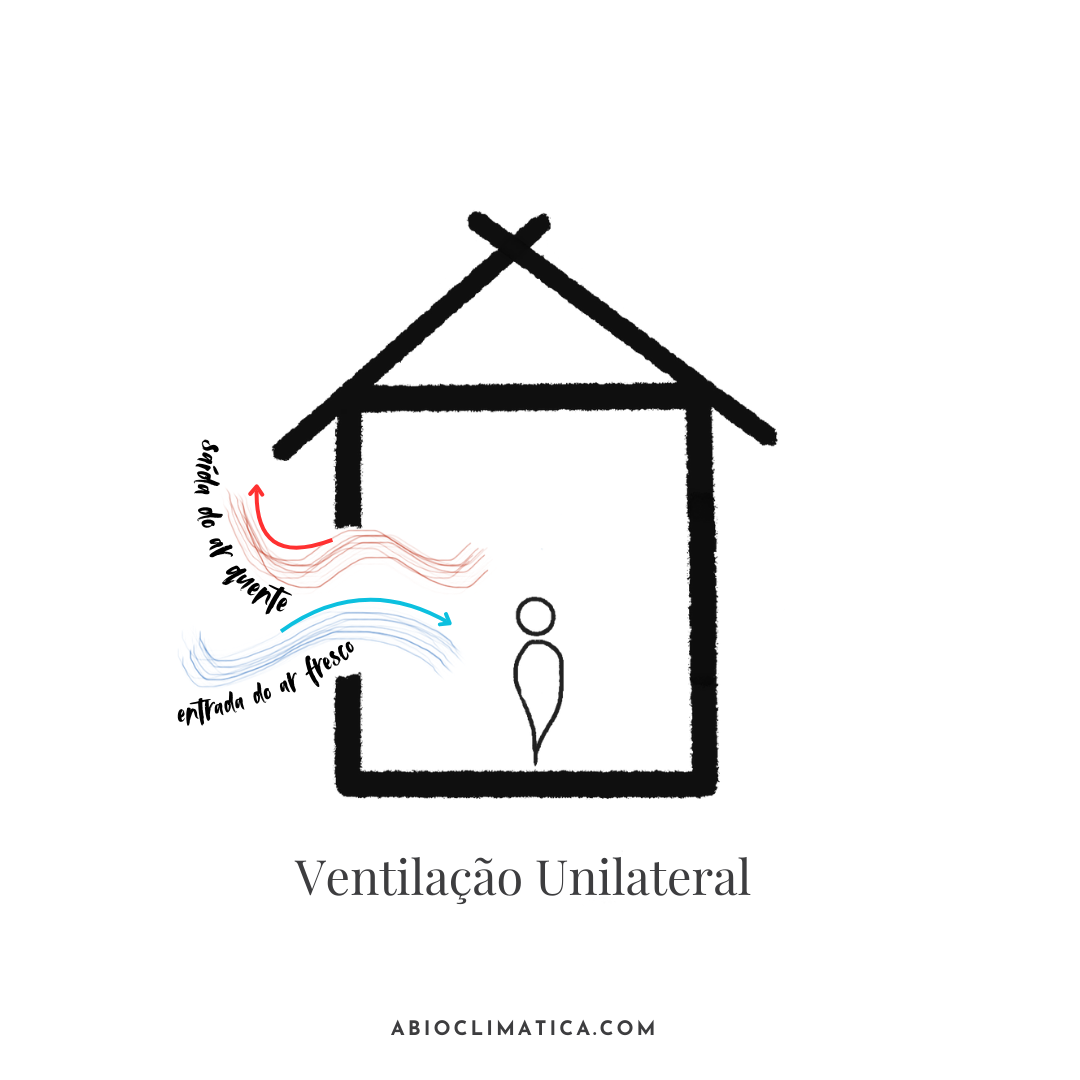
- Unilateral ventilation (single-sided): In this type of ventilation, fresh air intake and stale air outlet occur on opposite sides of the occupied space. Fresh air enters through an opening, such as a window, and stale air is expelled through an outlet, such as a chimney or exhaust duct.
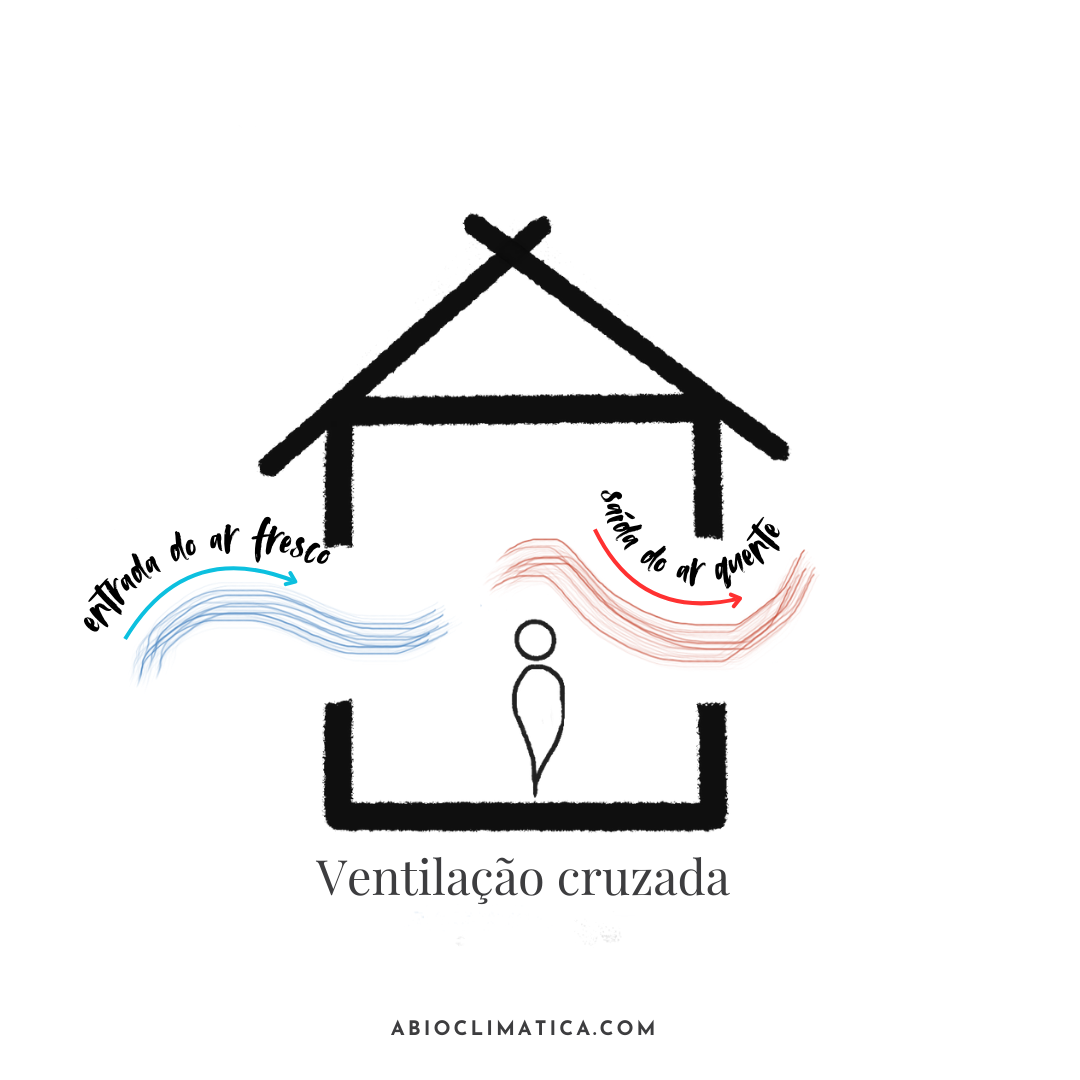
- Cross ventilation: In this type of ventilation, fresh air is pulled into the occupied space through an opening on one side and expelled through an opening on the opposite side. This strategy allows air to circulate more efficiently through the environment, promoting better ventilation and air renewal.
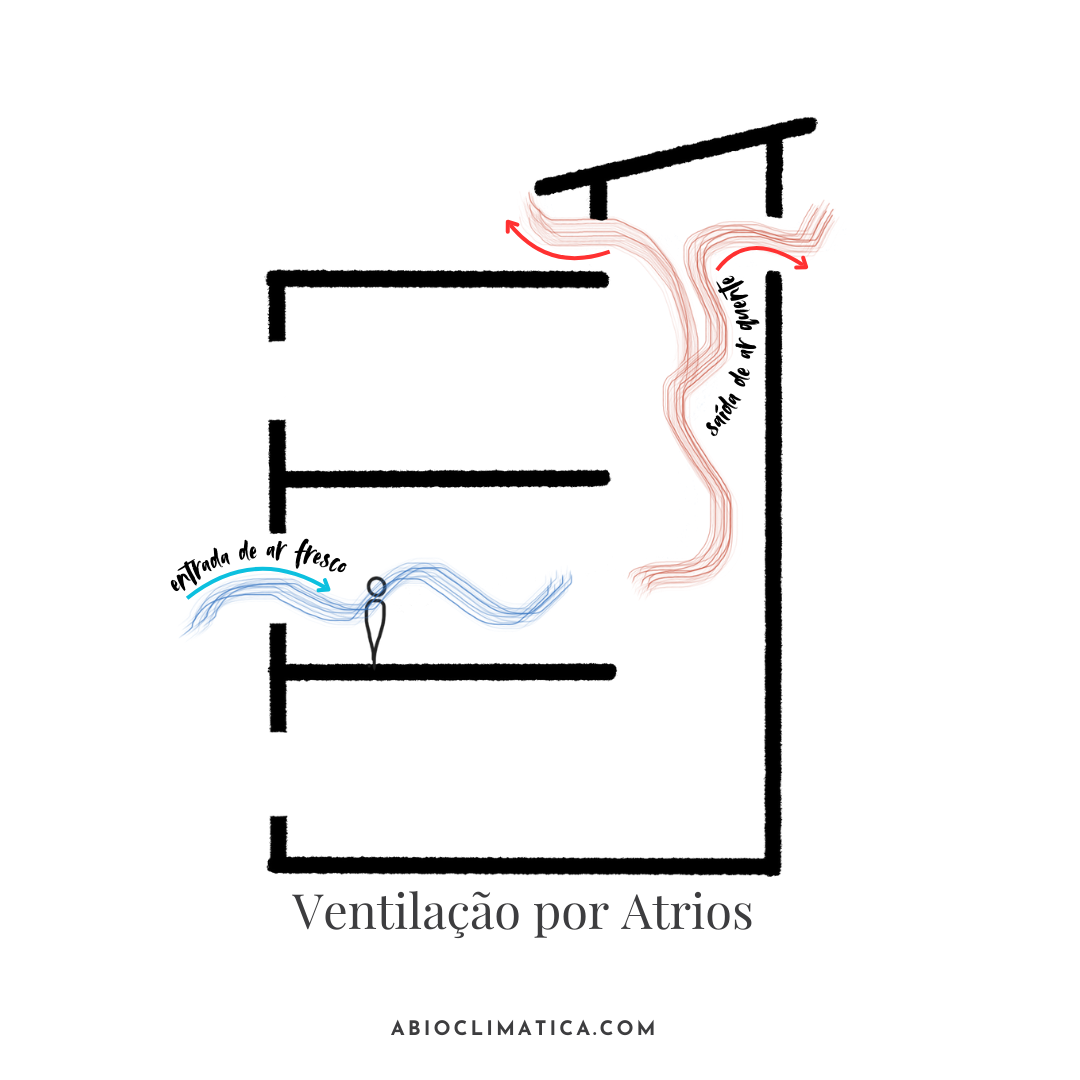
- Atria (single-cell): Atria are open internal spaces, usually located in the centre of a building, which allow for natural light entry and ventilation. In a single-cell atrium, the space is vertically continuous, allowing air to circulate freely from one floor to another, promoting natural ventilation.
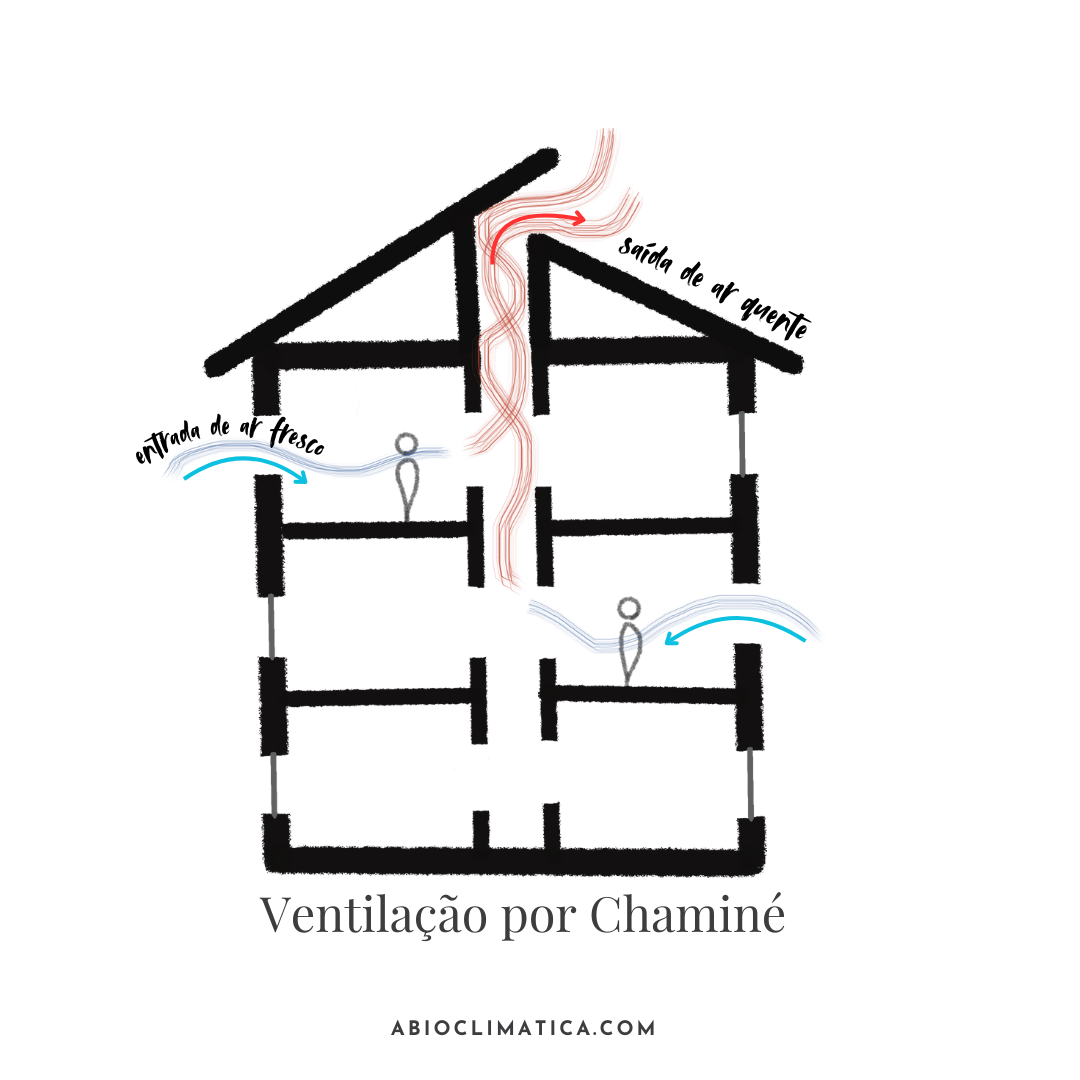
- Chimneys (multi-cell): Chimneys are vertical structures that allow for natural ventilation in buildings. In multi-cell chimneys, various openings are vertically distributed, allowing fresh air to be pulled into the building and stale air to be expelled outwards. These openings can be located at different levels of the building, promoting air circulation.
Standards and Software for Natural Ventilation Simulation in Buildings
There are various standards and software available to assist in the simulation of natural ventilation in buildings. Some of them are:
NBR 15220
The NBR 15220 is a Brazilian standard that establishes thermal comfort criteria in buildings. It defines methods and recommendations to ensure thermal comfort in buildings, taking into account factors such as temperature, humidity, and ventilation.
With regard to natural ventilation, the standard offers guidelines and criteria to promote adequate air circulation in environments. It recommends the presence of strategically positioned openings, such as windows, doors, and perforated elements, that allow the entry of fresh air and the exit of hot air.
Additionally, NBR 15220 establishes parameters for air velocity, aiming to avoid excessive air currents that could cause discomfort. The standard also considers the relationship between the opening area and the environment area, in order to ensure adequate ventilation.
ISO 7730
The ISO 7730 standard is an international standard that establishes the criteria for thermal comfort and measurements of environmental variables. It defines parameters such as air temperature, air velocity, relative humidity, and thermal radiation, which are fundamental for determining a person’s thermal comfort.
With regard to natural ventilation, the standard recommends the use of strategies that allow fresh air to enter the environment, such as opening windows or using natural ventilation devices, such as louvres or ventilation grilles. Additionally, the standard also provides guidance on the proper sizing of ventilation openings, considering factors such as the necessary air renewal rate and uniform distribution of air flow.
It is important to emphasise that these standards offer general guidelines and that the practical application of the recommendations may vary depending on the specific characteristics of the environment and the needs of the occupants. Therefore, it is always recommended to consult qualified specialists to ensure the adequacy of natural ventilation measures in compliance with the standards.
CIBSE Guide A and AM10
The Chartered Institution of Building Services Engineers (CIBSE) Guide A and AM10 are comprehensive guidelines for the design, implementation, and operation of environmental design, which also includes natural ventilation in buildings. They provide detailed criteria for various aspects of natural ventilation, including the design of ventilation openings, the arrangement of spaces to improve air flow, and the use of architectural features to promote air movement.
These guidelines are typically used during the design phase of construction projects to ensure that the ventilation system meets the needs of the building’s occupants and is aligned with environmental sustainability objectives. The importance of using these guidelines lies in their emphasis on improving indoor air quality, promoting energy efficiency, and enhancing the overall comfort of building occupants. Adherence to these guidelines ensures that the building’s natural ventilation system is effective and sustainable.
BS EN 13779
BS EN 13779 is a European standard that provides guidelines for ventilation and air conditioning of non-residential buildings. It describes the criteria necessary to design and evaluate the performance of ventilation systems, including natural ventilation strategies, to ensure a comfortable indoor environment. This standard is used during the design and implementation phase of construction projects and is crucial for specifying the minimum air quality requirements for different areas within a building. Its importance lies in its aim to improve the comfort, health, and productivity of occupants, ensuring efficient ventilation and good air quality.
ASHRAE Standard 55
The ASHRAE Standard 55 is an American standard that defines the criteria for thermal comfort in buildings. It establishes the limits of temperature, relative humidity, air velocity, and other parameters to ensure a comfortable environment for occupants.
For natural ventilation, Standard 55 recommends the use of passive strategies that allow fresh air to enter indoor environments. Some recommendations include the use of operable windows to promote air circulation, the use of strategically positioned openings to take advantage of external air currents, and the creation of cross ventilation zones to maximise air renewal.
Additionally, Standard 55 also provides calculation methods to determine the effectiveness of natural ventilation in a building, taking into account factors such as air renewal rate, air distribution in environments, and indoor air quality.
Simulation Software
In addition to standards, there are various simulation software that can be used to analyse natural ventilation in buildings. Some popular examples are:
- Optivent: A simple tool for natural ventilation where you can test airflow strategies and natural ventilation to optimise the initial phase of the project and ensure indoor air quality.
- Honeybee: A plugin for Grasshopper that allows detailed analyses of natural ventilation, natural lighting and thermal comfort, integrating with simulation engines such as EnergyPlus and Radiance.
- Butterfly: An extension of the Ladybug Tools ecosystem that uses OpenFOAM for computational fluid dynamics (CFD) simulations, ideal for detailed analyses of airflow and natural ventilation.
- Climate Studio: A comprehensive tool for environmental analysis in architecture that allows simulations of natural ventilation, natural lighting and energy performance in a single integrated environment.
Conclusion
By adopting strategies that favour air circulation naturally, it is possible to create more pleasant, economical, and sustainable spaces. Therefore, when designing or renovating an environment, take into consideration the importance of natural ventilation and take advantage of the benefits it can provide.
Remember to use appropriate standards and software to simulate and analyse natural ventilation in your projects. This will ensure that the measures adopted are efficient and comply with best practices.
Moreover, this construction technique, which directly dialogues with the climate and local context, offers a way to minimise dependence on electrical energy and, consequently, to reduce greenhouse gas emissions, representing a more sustainable future for the built environment.

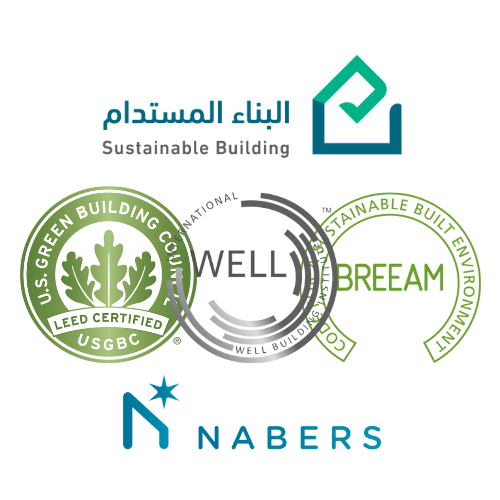

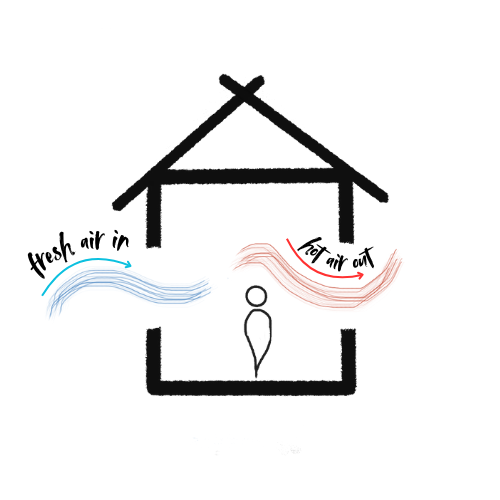



3 Comments